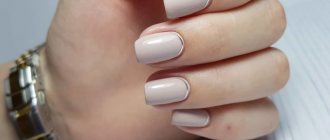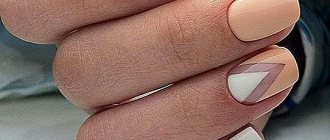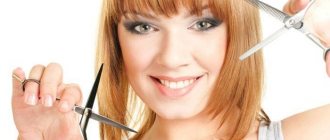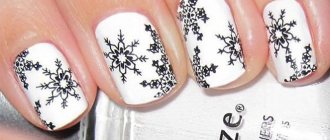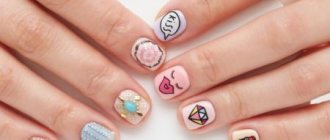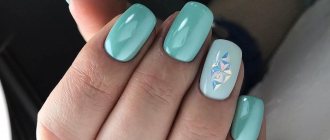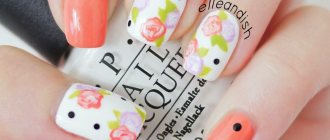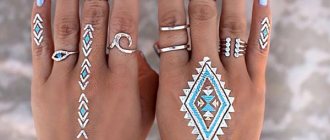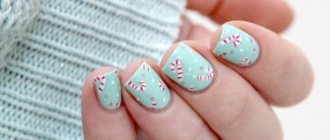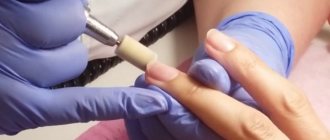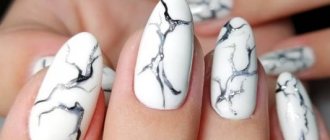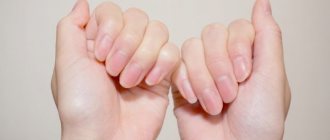Dermatologists believe that salon manicure and pedicure are not really necessary for nails; simple procedures at home will suffice for healthy nails. But even here you can screw up. We'll tell you how to disinfect scissors, why you shouldn't touch the cuticles, and how to avoid infections on your nails.
Even if you are used to doing manicures and pedicures in a salon, it will be useful to know how to do it all yourself correctly. It is important to monitor the condition of your nails - this will help prevent infections, ingrown nails and professional mistakes.
How to cut your nails correctly
Check if the tools are ready
Before you do anything to your nails, make sure your tools are sharp and clean enough.
Firstly, scissors or nippers (in a clever way - knipser!) should belong only to you - in terms of personal hygiene, there is no shame in being greedy. They also need to be disinfected. Let the tools sit in a bowl of alcohol (70-90 degrees), then clean them with a brush, rinse them in hot water and be sure to dry them.
Secondly, they need to be sharpened. If the tools are dull, they will have difficulty cutting your nails and may even damage the nail plate. Carefully cutting off hangnails with dull scissors will also not work - you are more likely to make new ones by approaching a piece of skin near the nail. You can sharpen tools for manicure and pedicure at home using sandpaper. Or entrust this matter to a master.
❓What to buy if you are going to do your own manicure
Beauty shop: 10 products for manicure at home
Don't shave your legs before cutting your toenails
Doctors from the Association of American Dermatologists advise shaving your lower legs after a pedicure. Otherwise, a small focus of infection may appear, which can spread to the nail.
Steam your nails before cutting
It is more convenient and easier to cut your nails after a bath or shower, when they are softened. It’s enough to just hold your feet under warm water for a couple of minutes and start cutting. Or soak your feet and hands in warm water baths for half an hour to relax and feel like you're in a spa. Throw on a robe and apply the mask to your face to enhance the effect.
The Association of American Dermatologists has its own YouTube channel where you can see how to properly care for your skin, hair and nails. How to use wire cutters correctly is in this video.
On your legs, cut straight and do not round the ends.
It is better to give the nails a square shape, and do not cut off the ends with clippers or scissors. If you cut your nails round and cut them deep, they can grow and dig into your skin. Ingrown toenails are unsightly, can cause inflammation, and can even land you in the surgeon's office. An ingrown toenail can even be removed if an infection develops. But if the lesion is small, you can get by by removing a small piece and using anti-inflammatory baths.
Finally, file your nails in one direction with a file.
A nail file is not needed to give your nails a beautiful shape. It removes roughness. This is to prevent you from scratching yourself or others, or from snagging on clothing. It is important to cut in one direction. It's useless to drive back and forth. This may cause the nail to become thinner or split.
How does a medical pedicure help with fungus and more?
Medical pedicure for nail fungus
About 20% of people suffer from fungus that has settled on the skin of the feet and nails. The following symptoms are observed:
- Changing the color of the nail plate;
- Nail deformation;
- Severe skin dryness and flaking;
- Redness of the skin, especially between the fingers;
- Formation of small cracks in the skin;
- Itching;
- Unpleasant smell.
Fungus can be cured quickly and painlessly with laser nail plate removal. The procedure does not cause bleeding. First, you should treat the skin of the feet and nails, after which you can begin antifungal therapy. Medical pedicure is a good method of fighting fungus because it does not take much time to treat the disease and does not require a large amount of medications. When a new nail grows, the specialist will do corrective treatment. To prevent the infection from spreading, the procedure is performed in surgical sterility.
Medical pedicure for ingrown toenails
A nail can become ingrown due to:
- Nail injuries;
- Too much shortening of the nail plate;
- Fungal nail diseases;
- Hereditary nature;
- Inconvenient shoes: narrow or small.
An ingrown toenail is accompanied by pain on the side of the nail, swelling and redness. It is important to take action in time, otherwise pus will appear under the skin, infection will occur, and over time the pus will leak out. If you do not contact a specialist in time, then it is extremely undesirable to treat yourself, because there is a possibility of infection in the blood.
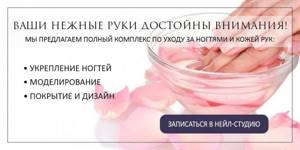
The following are the methods for treating ingrown toenails that a medical pedicure offers:
- Goldspang
. A special plate is attached to the nail, which straightens the edge of the nail, which allows you to treat the problem area.
- Surgical
. This is a radical method of treating ingrown toenails, in which the nail plate with the defect is simply removed.
- Trimming the edges of the nail
. The method is acceptable if you contact a specialist immediately.
- Laser nail removal.
- Orthonyxia
- straightening the nail using special staples.
- Prosthetics
.
- Podofix plate,
which is a strip of elastic plastic and is glued to the nail using a special glue, after which it is attached to it with a metal wire. This method of treatment is used for the proliferation of nearby tissues (hypergranulation), treatment of calluses with a core in the area of the nail fold, and curled nails.
- Onyklip plate.
Used for increased sensitivity of the side roller. An epoxy-coated metal plate is glued to the nail.
- Duroplastic plate,
covered with fiberglass. It is attached to the nail, and it lifts its edges above the side ridges due to its springy properties.
- COMBIped technique
used for unilateral ingrowth of the nail plate, inflammation of the nail folds and curling of the nail. A metal staple with one curved end is inserted under the nail plate. On the other side, the staple has a plastic pad that is attached to the top of the nail, so you can only adjust one edge of the nail.
Medical pedicure for diabetic foot syndrome
If you suffer from diabetes, then a possible complication is diabetic foot syndrome, in which the following occurs:
- The skin, nerves, blood vessels, bones, joints are affected;
- Blood circulation in the extremities is impaired;
- The threshold of sensitivity in the limbs decreases;
- Legs go numb;
- The temperature in the lower extremities decreases;
- Injuries and wounds take a long time to heal;
- Nails become deformed, the nail plate becomes thicker;
- Dry skin is observed;
- The leg muscles atrophy;
- Trophic ulcers and fungal infections appear.
We can conclude that if you have diabetes, you should under no circumstances remove calluses, ingrown nails, or perform other actions that could damage the skin. The best way out is to contact a specialist and get a medical pedicure. Professionals using special devices will be able to remove rough skin and calluses using diamond tips. They will also be able to relieve you of the problem of ingrown toenails. To improve blood flow in your legs, you should also sign up for a massage session.
Medical pedicure for cracked heels and toes
Sebaceous glands nourish and moisturize the skin, but there are no sebaceous glands on the feet. This is associated with the appearance of cracks. But this is not the only reason for dry skin on the feet. Another reason is a lack of vitamins and a dense stratum corneum, which causes the heels and toes to crack. The cracks cause pain, making it impossible to fully step on the foot. Blood flows from the wound, which leads to the risk of infection or dirt. Since the skin layer is thick, it receives little nutrition and is subject to constant stress. All this only makes the situation worse, and such wounds take a long time to heal.
Causes of cracks:
- Failure in the endocrine system;
- Wearing flip-flops, flip-flops and slippers;
- Poor quality pedicure;
- Dry and hot air;
- Fungal infections.
Cracks can be easily cured with a medical pedicure. Special tools are provided for this. The rough layer of skin is cut off, the edges of the wound are polished with a ceramic tip, then the crack is treated with ointment. In the future, this ointment should be used at home on your own until the skin heals.
Medical pedicure for hyperhidrosis
It has already been said that the skin of the legs does not have sebaceous glands, but it has many sweat glands. Hyperhidrosis is a disease associated specifically with increased sweating of the feet. If the hormonal balance in the body is disturbed, or you wear shoes that do not allow air to pass through, or you have experienced stress, or the temperature is elevated, then sweating increases. As a result, an environment with elevated temperature and humidity is formed in which bacteria multiply and fungus spreads.
Hyperhidrosis is treated with reflexology, which stimulates blood circulation and improves the functioning of the nervous system. The medical pedicurist performs acupressure using cooling and relaxing agents and essential oils. Some remedies can also be used for home treatment.
Medical pedicure for corns and hyperkeratosis
Since the feet regularly experience pressure and stress, the skin in those places where strong pressure occurs coarsens, becomes hard and dense, which is why dry calluses and stratum corneum form. When a callus appears, a person feels pain, especially when walking for a long time. Your foot hurts a lot and you get tired quickly.
The causes of hyperkeratosis are as follows:
- Being overweight or tall, which puts increased stress on the feet;
- Standing work, for example, hairdresser. As a result of prolonged exposure to certain points of the sole, the skin becomes horny;
- Impaired metabolism;
- Lack of vitamins;
- Inconvenient and low-quality shoes;
- Deformation of the feet;
- Excessive dryness of the skin of the feet.
Medical pedicure in such cases involves treating the affected areas with ceramic caps. To soften the skin, they do not use baths, as in a regular pedicure, but special formulations consisting of liquids and gels.
Medical pedicure for skin or core nails
A skin nail is a type of callus that is a manifestation of hyperkeratosis. The core nail is smaller in area, but penetrates deep into the skin. This disease is called skin nail because when walking a person feels pain, as if a nail had pierced the sole of the shoe and dug into the leg. Typically, these calluses appear on the heels, balls of the feet, knuckles on the outside of the toes, and between the toes. The causes are wearing tight shoes, injuring the foot with a pebble caught in the shoe. In the latter case, the body protects the foot from damage, resulting in the formation of a callus. At the site of “irritation,” epidermal cells divide and grow, resulting in hyperkeratosis that penetrates deeply. In addition to the listed reasons, this disease also occurs as a manifestation of a dermatotropic virus.
Skin nails are treated during a medical pedicure. It is drilled out with special drills and cutters. This is the most effective way to get rid of a core nail. When it is removed, a hole remains. To prevent inflammation from starting, a medicine is injected into it. Typically, five treatments are required for complete cure.
What is good about medical hardware pedicure?
- Medical pedicure is safe. The risk of skin breakage is very small, so the client is unlikely to become infected.
- The possibility of damage is also reduced by the fact that the skin is softened not by steaming or baths, but by special preparations.
- The possibility of cross-infection is eliminated since the procedure uses disposable tips. They stimulate reflexogenic zones, which leads to improved well-being.
- The products used (creams, lotions, softeners) contain wound-healing components.
- The procedure should only be performed by a specialist with medical education.
How to care for your cuticle
Dermatologists are against cuticle cutting
Dermatologists from the American Association urge not to touch the cuticles. After all, it protects nails from bacteria and germs. Without it, the nail is always in danger. If after a manicure at home there is no inflammation on your hands and feet, thank the sterilized instrument and active immunity.
Doctors also do not advise pushing back the cuticle - this can injure the root of the nail and provoke paronychia. This is when bacteria or fungi enter the damaged area of the nail, and this causes inflammation. It seems that the combination manicure popular in salons, which is called “Russian” abroad, is not very beneficial for the health of nails.
The cuticle does not need to be trimmed, but can be removed using special means.
And yet, without cuticles, nails look neater. You can get rid of it, but instead of scissors you will need cuticle remover and orange sticks. This is how an unedged manicure is done.
Cuticle removers remove the layer of dead skin. There are two ways to do this - using soft and aggressive components. Mild products contain AHA acids, aggressive products contain alkalis. Acidic ones irritate and dry the skin less, so it is better to choose them.
